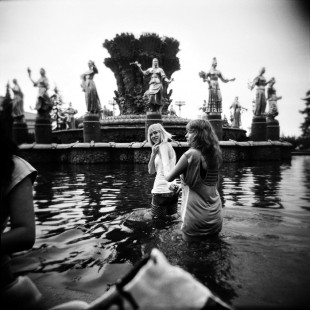VDNKh. Soviet antiquity
Published on 06/08/11

© Varvara Lozenko
VDNKh is a park in northwest Moscow. It occupies 2,375,000 square meters which is greater than territory of the Principality of Monaco. It houses more than 80 pavilions and monuments originally designed to showcase the achievements of the USSR. Each one is devoted to a specific aspect of the Soviet Union: agriculture, economics, science, industry, cosmos etc. The VDNKh’s genesis was the All-Union Agricultural Exhibition (VSKhV) of 1939. This display of the fruits of Socialism and showpiece of Stalinist monumental art was intended to open two years earlier, but was delayed by the purging of many of its leading participants. In 1959 the park was renamed Exhibition of Achievements of the National Economy (Vystavka Dostizheniy Narodnovo Khozyaystva) or ВДНХ/VDNKh. In 1992, VDNKh was renamed, receiving its current name VVC (All Russia Exhibition Center. For many generations of Soviet people it has been a must to visit in Moscow, so-called Soviet Disneyland. Today, the term “VDNKh” is still in use.. TEXT BY Varvara Lozenko: The USSR was a semi-surreal country where everything was based upon mythology and future was the only relevant time category. By the year so and so communism will be attained. And every Soviet family will flourish in prosperity, with free apartments and all sorts of commodities showering on them — in the future, by the year so and so. The present was smirky and unstable, and the past was completely crossed out.
But it was necessary to incorporate that almost sacramental attitude towards the future into some sort of material basis that would have some sort of time reference. And then — of all the epoques of human history — the Antiquity was ladled out. Good choice! This resulted in a curious configuration — both from the point of view of history as well as art history. The Soviet myth seemed to derive from things like ancient democracy of the Athens and the Roman republic. To derive immediately, skipping all the chapters of human history as if it were some sort of irrelevant nonsense. And the All-Soviet agricultural exhibition (as it was originally called) that later evolved into the Exhibition of the Achievements of the Peoples’ Industry became a model of that ideal state, a Soviet empire in miniature. But it’s not that safe to joke with History. By Jove, the History is sensitive to jokes of the kind. You wanted irony on the history level, didn’t you? Well, here you are. The dignified pavilions resembling ancient temples that first housed exhibitions of now non-existant branches of industry and were later converted into pavilions of the Soviet republics eventually degraded into kiosks selling seeds and honey (for whatever reason that completely escapes me). Just the way the neoantique Soviet empire lost its provinces, its miniature model, the Exhibition of achievements of the Peoples’ Industry lost letters — the acronym changed from VDNHh into VVC. But the most appropriate name for the place would be the Soviet history disneyland.

© Varvara Lozenko
So here it is — the crumbling away stucco, the cracked columns and the degraded sculptures, and now it seems that the Soviet antiquity resembles the Greek and Roman prototypes more than ever. Actually, it almost looks older. And where are those peoples whose women in the centre of the Peoples’ Friendship fountain symbolize the mythical friendship of the Soviet republics? Where are the fattened pigs, cows, horses, sheep that several decades ago filled those pavilions and symbolized the achievements of the Soviet industry and agriculture — from rabbit breeding to computer science? And where are the people, the legendary people, those brave, hard-working Soviet people, pioneers of industrialization and conquerors of the space? Where are they, the contemporaries of my parents and grand-parents, those who had the word “USSR” once stamped into the passport and forever into the soul? They are long gone, vanished in time and sunken into dust. Like a lost civilization, like the people of the Atlantis. Only their shadows — one walking with a stick, one walking a grandson or a deaf dog, one wearing a outfashioned straw hat — they shuffle along the half-antique half-ruins. Walking at a slow pace, they are remembering the glorious past that they have rushed past by because when it was their present everyone was thinking only about the future.


